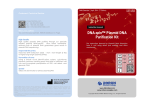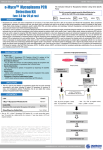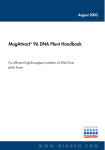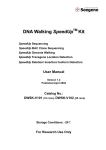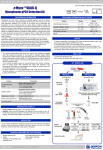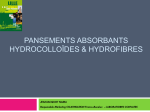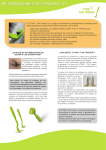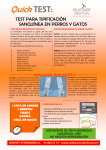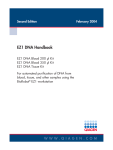Download DNA Extraction November, 2011 (4th Edition)
Transcript
DNA Extraction │ November, 2011 (4th Edition) ISO 9001 ISO 14001 Instruction manual The Instruction Manual for fragment DNA Extraction from agarose gel, PCR product and enzymatic reaction using silica membrane. REF 17286 Σ REF 17287 Σ 17288 Σ REF RUO www.intronbio.com www.intron-innoplex.com Copyright © 2011 iNtRON Biotechnology, Inc. All right reserved 50 200 200 Product info. 1 INDEX INDEX Kit Information Protocols Additional information Description 2 Characteristics 2 Kit Contents 3 Storage 3 Consideration Before Use 4 Safety Information 4 Additional Required Equipment 4 Applications 5 Quality Control 5 Column Information 6 Technical Assistance 6 Protocol A (Gel DNA Extraction) 7 Protocol B (PCR Purification, DNA Clean-up) 9 Quick Guide 10 Troubleshooting Guide 11 Technical Advise 12 Experimental Information 15 Global Distributors 17 MEGAquick-spin™ Total Fragment DNA Purification Kit DNA-spin™ Plasmid DNA Purification Kit 2 Kit Information DESCRIPTION • The MEGAquick-spin™ Total Fragment DNA Purification Kit is designed to extract and purify DNA fragments of 60 bp ~ 20 kb from normal or low-melt agarose gels in either Tris acetate (TAE) or Tris borate (TBE), or to purify PCR products directly from a PCR amplification and DNA cleanup from other enzymatic reactions. Recovery is achieved up to 95%. PCR products are commonly purified to remove excess nucleotides and primers. This membrane-based system, which can bind up to 45 μg DNA, allows recovery of isolated DNA fragments or PCR products in as little as 20 minutes, depending on the number of samples processed and the protocol used. The purified DNA can be used for automated fluorescent DNA sequencing, cloning, labeling, restriction enzyme digestion or in vitro transcription/translation without further manipulation. • The BNL Buffer are optimized for efficient recovery of DNA and removal of contaminants. As an added convenience from gel extraction procedures, the BNL Buffer contains a color indicator that allows easy monitoring of the solution pH for optimal DNA binding. • The MEGAquick-spin™ Total Fragment DNA Purification Kit is ideal multi-functional (Gel extraction, PCR purification and DNA clean-up) product for isolation of fragment DNA. CHARACTERISTICS • Multifunction Gel extraction, PCR purification and DNA clean-up • Improved recovery Up to 95% recovery of ready-to-use DNA • Simple and easy process Fast procedure, Cleanup of DNA up 60 bp ~ 20 Kb in three easy steps • Prevention of error Easy determination of the optimal pH for DNA binding MEGAquick-spin™ Total Fragment DNA Purification Kit DNA-spin™ Plasmid DNA Purification Kit 3 Kit Information KIT CONTENTS Contents Contents 50 Columns 200 Columns Agarose gel lysis buffer 40 ml 140 ml Washing Buffer (concentrate) 2 Washing buffer 10 ml 40 ml Elution Buffer Elution buffer 20 ml 20 ml 50 Col. (17286) 200 Col. (17287) Label Description BNL Buffer1 MEGAquick- spin™ column (Blue column w/o Cap) MEGAquick- spin™ column (Clear Column with cap & dark blue O-ring) Nucleic acid binding column 2 ml polypropylene tube Collection tube 200 Col. (17288) Nucleic acid binding column 50 tubes 200 tubes 1 BNL Buffer contains chaotropic salts which are irritants. Take appropriate laboratory safety measures and wear gloves when handling. 2 Washing Buffer is supplied as concentrate. Add 40 ml (50 columns) or 160 ml (200 columns) per each bottles of ethanol (96~100%) according to the bottle label before use. STORAGE MEGAquick-spin™ Total Fragment DNA Purification Kit should be stored dry at room temperature (15–25°C). Under these conditions, MEGAquick-spin™ Total Fragment DNA Purification Kit can be stored for up to 24 months without showing any reduction in performance and quality. Check buffers for precipitate before use and redissolve at 37°C if necessary. The entire kit can be stored at 2–8°C, but in this case the buffers should be redissolved before use. Make sure that all buffers and spin columns are at room temperature when used. The term of validity is marked on the box. MEGAquick-spin™ Total Fragment DNA Purification Kit DNA-spin™ Plasmid DNA Purification Kit 4 Kit Information CONSIDERATION BEFORE USE A typical agarose gel slice is solubilized by adding 3 volumes of BNL Buffer to 1 volume of gel (e.g., 300 μl of BNL Buffer is added to 100 mg gel slice) and incubating at 55°C for 10 minutes. The high concentration of a chaotropic salt in BNL Buffer disrupts hydrogen bonding between sugars in the agarose polymer, allowing solubilization of the gel slice. In addition, the high salt concentration dissociates DNA binding proteins from the DNA fragments. If water is used for elution, make sure that its pH is between 7.0 and 8.5. Elution efficiency is dependent on pH and the maximum elution efficiency is achieved within this range. A pH <7.0 can decrease yield. Note : Store DNA at –20°C when eluted with water, as DNA may degrade in the absence of a buffering agent. SAFETY INFORMATION All chemicals should be considered as potentially hazardous. When working with chemicals, always wear a suitable lab coat and disposable glove. Some buffers contain the chaotropic salt which may be an irritant and carcinogen, so appropriate safety apparel such as gloves and eye protection should be worn. If a spill of the buffers occurs, clean with a suitable laboratory detergent and water. If the liquid spill contains potentially infectious agents, clean the affected area first with laboratory detergent and water, then with a suitable laboratory disinfectant. Only persons trained in laboratory techniques and familiar with the principles of good laboratory practice should handle these products. DO NOT add bleach or acidic solutions directly to the sample preparation waste. ADDITIONAL REQUIRED EQUIPMENT Agarose(iNtRON, Cta. No. 32032); scalpel Gel running buffer: TAE buffer or TBE buffer Electrophoresis Sterile Absolute ethanol Standard tabletop micro-centrifuge Micro-centrifuge tubes, sterile (1.5 ml) TE buffer (10 mM Tris-HCl, 0.1 mM EDTA; pH 8.0 - 8.5) MEGAquick-spin™ Total Fragment DNA Purification Kit DNA-spin™ Plasmid DNA Purification Kit 5 Kit Information APPLICATIONS MEGAquick-spin™ Total Fragment DNA Purification Kit is designed for the efficient isolation of DNA fragments from TAE or TBE agarose gels or direct purification of PCR products. The purified DNA can be used for automated fluorescent DNA sequencing, cloning, restriction enzyme digestion and routinely performed DNA manipulation. QUALITY CONTROL • In accordance with iNtRON’s ISO-certified Total Quality Management System, each lot of MEGAquick-spin™ Total Fragment DNA Purification Kit is tested against predetermined specifications to ensure consistent product quality. • The quality of the isolated fragment DNA was checked by agarose gel electrophoresis, and spectrophotometric determination. • MEGAquick- spin™ column control The DNA binding capacity was tested by determining the recovery obtained with 20 μg of input fragment DNA. More than 70% recovery was obtained. • Buffer control Conductivity and pH of buffers were tested and found to be within the predeterminated ranges Buffer Conductivity pH BNL 190 ~ 200 mS/cm 5.8 ~ 6.2 14 ~ 16 mS/cm 7.4 ~ 7.8 450 ~ 700 μS/cm 8.0 ~ 8.5 Washing B Elution MEGAquick-spin™ Total Fragment DNA Purification Kit DNA-spin™ Plasmid DNA Purification Kit 6 Kit Information COLUMN INFORMATION • The MEGAquick-spin™ Total Fragment DNA Purification Kit Spin Column Column membrane1 Spin Column1 Loading Volume Silica-based membrane Individually, in inserted in a 2.0 ml Collection Tube Maximum 800 μl DNA Binding Capacity Maximum 45 μg Recovery 85 - 95% depending on the elution volume Elution Volume Generally, eluted with 30 – 200 μl of Elution Buffer 1. Do not store the Column packs under completely dried conditions. It may be affected to DNA binding capacity. The Spin Columns are stable for over 2 year under these conditions TECHNICAL ASSISTANCE At iNtRON, we are proud of ourselves on the quality and availability of our technical support. Our Technical Service Departments are staffed by experienced scientists with extensive practical and theoretical expertise in molecular biology and the use of iNtRON products. If you have any questions or experience any difficulties regarding the MEGAquick-spin™ Total Fragment DNA Purification Kit or iNtRON products in general, please do not hesitate to contact us. MEGAquick-spin™ Total Fragment DNA Purification Kit DNA-spin™ Plasmid DNA Purification Kit 7 Protocols PROTOCOL A (Gel DNA Extraction) 1. Load and run the gel using an established protocol. DNA can be extracted from standard or low-melt agarose gels in TAE or TBE buffer. 2. After electrophoresis, cut out the interesting DNA fragment with a sharp scalpel or razor blade. Carefully take as much agarose gel as possible. Note : If sliced agarose gel put into BNL Buffer, the total volume may be increased. When highly concentrated BNL buffer is diluted, and it results low elution efficiency. Therefore, minimize the size of the gel slice by removing extra agarose. Note : The gel slice may be stored at 4℃ or -20℃ for up to one week in a tightly closed tube under nuclease-free conditions before purification. 3. Weigh the gel slice in a 1.5 ml tube. Add 3 volumes of BNL Buffer to 1 volume of gel (300 ml per 100 mg of agarose gel). Note : Add 300 ml of BNL Buffer to each 100 mg of gel. If more than 2% of agarose gel, add 6 volumes of BNL Buffer. 4. Vortex the mixture and incubate at 55℃ for 10 minutes or until the gel slice is completely dissolved. To help dissolving gel, vortex every 2 ~ 3 min during the incubation. Note : Vortex the tube every few minutes to increase the rate of agarose gel melting. Centrifuge the tube briefly at room temperature to ensure that the contents are at the bottom of the tube. Once the agarose gel is melted, the gel will not resolidify at room temperature. Note : Completely solubilize agarose. For > 2% agarose gel, increase incubation time. Note : If the color of the mixture is orange or violet, add 10 μl of 3 M sodium acetate, pH 5.0, and mix. The color of the mixture will turn to yellow. The adsorption of DNA to the QIAquick membrane is efficient only at pH ≤7.5. BNL Buffer contains a pH indicator which is yellow at pH ≤7.5 and orange or violet at higher pH, allowing easy determination of the optimal pH for DNA binding. 5. (Optional) For < 200 bp, add 1 gel volume of isopropanol to dissolved gel solution of the step 5 and mix well by pipetting several times. Do not centrifuge after mixing well. Note : For < 200 bp of DNA fragment, add 1 volume of isopropanol to 1 volume of gel, and mix well. If the agarose gel slice is 100 mg, add 100 ml of isopropanol. When adding the isopropanol and mixing well by pipetting, small white pellet and clump should be formed. But never mind, and go to the following step. This step increases the yield of DNA fragment. For DNA fragment > 200 bp, adding isopropanol has no effect on yield. 6. Place one MEGAquick-spin™ column in a Collection Tube for each dissolved gel mixture. MEGAquick-spin™ Total Fragment DNA Purification Kit DNA-spin™ Plasmid DNA Purification Kit 8 Protocols 8. Transfer the dissolved gel mixture to the MEGAquick-spin™ column assembly. 9. To bind DNA, apply the sample to the MEGAquick-spin™ column, and centrifuge for 1 min. Discard the flow-through after centrifuging and place the MEGAquick- spin™ column back in the same 2 ml collection tube. Note : The maximum volume of the MEGAquick-spin™ column reservoir is 800 ml. For sample volumes of more than 800 ml, simply load and spin again. 10. Add 700 ml of Washing Buffer to column and centrifuge at 13,000 rpm for 1 min. Discard the flow-through after centrifuging and place the MEGAquickspin™ column back in the same 2 ml collection tube. Note : If the DNA will be used for salt sensitive applications, such as blunt-end ligation and direct sequencing, repeat the step 4 using 500 ml of Washing Buffer. 11. Centrifuge for 1 min at 13,000 rpm to dry the spin membrane. Note : It is important to dry the spin membrane since residual ethanol may interfere with other reactions. 12. Place the MEGAquick-spin™ column to a clean 1.5 ml microcentrifuge tube (not provided). Apply 30 ~ 100 ml of the Elution Buffer directly to the center of the column without touching the membrane with the pipette tip. Incubate at room temperature for 1 minute. Centrifuge for 1 minute at 13,000 rpm. 13. Discard the MEGAquick-spin™ column and store the microcentrifuge tube containing the eluted DNA at -20℃. Note : It is suggested to use at least 30 ml of the Elution Buffer to obtain best result. Note : Ensure that the elution buffer is dispensed directly onto the MEGAquick-spin™ membrane for complete elution of bound DNA. The average eluate volume is 48 μl from 50 μl elution buffer volume, and 28 μl from 30 μl Elution Buffer. Note : Elution efficiency is dependent on pH. The maximum elution efficiency is achieved between pH 7.0 and 8.5. When using water, make sure that the pH value is within this range, and store DNA at –20°C as DNA may degrade in the absence of a buffering agent. The purified DNA can also be eluted in TE buffer (10 mM Tris·Cl, 1 mM EDTA, pH 8.0), but the EDTA may inhibit subsequent enzymatic reactions. MEGAquick-spin™ Total Fragment DNA Purification Kit DNA-spin™ Plasmid DNA Purification Kit 9 Protocols PROTOCOL B (PCR Purification, DNA Clean-up) 1. Amplify target sample using standard amplification conditions. (or Prepare the DNA mixture enzymatically reacted for clean-up) 2. Add an 5 volume of BNL Buffer to the PCR reaction product, and mix well by vortexing. If the PCR product is 20 ml, add 100 ml of BNL buffer to the PCR tube directly. Note : Centrifuge the tube briefly at room temperature to ensure that the contents are at the bottom of the tube. Note : If the color of the mixture is orange or violet, add 10 μl of 3 M sodium acetate, pH 5.0, and mix. The color of the mixture will turn to yellow. The adsorption of DNA to the MEGAquick-spin™ membrane is efficient only at pH ≤7.5. BNL Buffer contains a pH indicator which is yellow at pH ≤7.5 and orange or violet at higher pH, allowing easy determination of the optimal pH for DNA binding. 3. (Optional) For < 200 bp, Add 1.5 volume of isopropanol to the sample and mix well by pipetting several times. Do not centrifuge after mixing well. Note : For < 200 bp, Add 1.5 volume of isopropanol, and mix well. If the PCR product is 20 ml, add 100 ml of BNL Buffer and 150 ml of isopropanol. This step increases the yield of DNA fragment. 4. Place one MEGAquick-spin™ column in a Collection Tube for each DNA gel mixture. 5. Transfer the DNA mixture to the MEGAquick-spin™ column assembly. 6. To bind DNA, apply the sample to the MEGAquick-spin™ column, and centrifuge for 1 min. Discard the flow-through after centrifuging and place the MEGAquick-spin™ column back in the same 2 ml collection tube. Note : The maximum volume of the MEGAquick-spin™ column reservoir is 800 ml. For sample volumes of more than 800 ml, simply load and spin again. 7. Add 700 ml of Washing Buffer to column and centrifuge at 13,000 rpm for 1 min. Discard the flow-through after centrifuging and place the MEGAquickspin™ column back in the same 2 ml collection tube. Note : If the DNA will be used for salt sensitive applications, such as blunt-end ligation and direct sequencing, repeat the step 4 using 500 ml of Washing buffer. 8. Centrifuge for 1 min at 13,000 rpm to dry the spin membrane. Note : It is important to dry the spin membrane since residual ethanol may interfere with other reactions. MEGAquick-spin™ Total Fragment DNA Purification Kit DNA-spin™ Plasmid DNA Purification Kit 10 Protocols 9. Place the MEGAquick-spin™ column to a clean 1.5 ml microcentrifuge tube (not provided). Apply 30 ~ 100 ml of the Elution Buffer directly to the center of the column without touching the membrane with the pipette tip. Incubate at room temperature for 1 minute. Centrifuge for 1 minute at 13,000 rpm. 10. Discard the MEGAquick-spin™ column and store the microcentrifuge tube containing the eluted DNA at -20℃. Note : It is suggested to use at least 30 ml of the Elution Buffer to obtain best result. Note : Ensure that the elution buffer is dispensed directly onto the MEGAquick-spin™ membrane for complete elution of bound DNA. The average eluate volume is 48 μl from 50 μl elution buffer volume, and 28 μl from 30 μl elution buffer. Note : Elution efficiency is dependent on pH. The maximum elution efficiency is achieved between pH 7.0 and 8.5. When using water, make sure that the pH value is within this range, and store DNA at –20°C as DNA may degrade in the absence of a buffering agent. The purified DNA can also be eluted in TE buffer (10 mM Tris·Cl, 1 mM EDTA, pH 8.0), but the EDTA may inhibit subsequent enzymatic reactions. Quick Guide MEGAquick-spin™ Total Fragment DNA Purification Kit DNA-spin™ Plasmid DNA Purification Kit 11 Additional Information TROUBLESHOOTING GUIDE Problem Low or no yield DNA does not perform well, e.g., in enzyme reaction, ligation, sequencing reactions BNL Buffer become violet color. Possible Cause Recommendation Washing buffer did not contain ethanol • Ethanol must be added to Washing buffer use. before Inappropriate elution buffer • DNA will only be eluted in low salt buffer or water. Incorrect volume of BNL buffer • Verify that a correct volume of BNL buffer was added to the gel slice. Gel slice incompletely solubilized • After addition of BNL buffer to the slice, mix by vortexing the tube every 2 minutes during the 55 ℃ incubation. Cloudy and gelatinous appearance of sample mixture after addition of isopropanol • This may be due to salt contamination, and will be disappeared by mixing the sample. Alternatively, the gel slice may not be completely solubilzed. The concentration of gel may be above 2%. In this case, apply the 6 volume of BNL buffer to gel slice, and melt the gel completely.. Salt concentration in eluate too high • Modify the washing step by incubating the column for 5min at RT after adding 700 ml of Washing Buffer and the centrifuge. Eluate contaminated • If The gel slice is incompletely solubilized or overwith agarose weighed, increased the incubation time. Eluate contains residual ethanol • Ensure that the wash flow-through is drained from the collection tube and that the column is then centrifuged at 13,000 rpm for 1min. Eluate contain primer- dimers • Primer dimers formed are longer than 50bp, and are not completely removed. • After binding step, wash the column with 750 ml of a 35% guanidine hydrochloride aqueous solution. Follow with the washing, and elution step as in the protocols. pH of electrophoresis buffer too high • The electrophoresis buffer has been repeatedly used or incorrectly prepared, resulting in a sample pH that exceeds the buffering capacity of BNL Buffer and leads to inefficient DNA binding. Add 0.1 volume of 3M sodium acetate, pH 5.0, to the sample and mix. MEGAquick-spin™ Total Fragment DNA Purification Kit DNA-spin™ Plasmid DNA Purification Kit 12 Additional Information TECHNICAL ADVICE ◈ Principle of gel analysis Gels allow separation and identification of nucleic acids based on charge migration. Migration of nucleic acid molecules in an electric field is determined by size and conformation, allowing nucleic acids of different sizes to be separated. However, the relationship between the fragment size and rate of migration is non-linear, since larger fragments have greater frictional drag and are less efficient at migrating through the polymer. Agarose gel analysis is the most commonly used method for analyzing DNA fragments between 0.1 and 25 Kb. Other specialized analytical gel methods exist for analyzing extremely large or small DNA molecules. Detailed information on all types of analytical gels can be found in current molecular biology manuals. ◈ Agarose concentration The concentration of agarose used for the gel depends primarily on the size of the DNA fragments to be analyzed. Low agarose concentrations are used to separate large DNA fragments, while high agarose concentrations allow resolution of small DNA fragments Concentration of agarose used for separating DNA of different sizes Agarose conc. (% w/v) DNA fragment range (Kb) Agarose conc. (% w/v) DNA fragment range (Kb) 0.3 0.7 1.2 2.0 5 – 60 0.8 – 12 0.4 – 7 0.05 – 2 0.5 1.0 1.5 1 – 30 0.5 – 10 0.2 – 3 ◈ Electrophoresis buffers The most commonly used buffers for agarose gel electrophoresis are TBE (Trisborate–EDTA) and TAE (Tris-acetate–EDTA). Although more frequently used, TAE has a lower buffering capacity than TBE and is more easily exhausted during extended electrophoresis. TBE gives better resolution and sharper bands, and is particularly recommended for analyzing fragments <1 Kb. The drawback of TBE is that the borate ions in the buffer form complexes with the cisdiol groups of sugar monomers and polymers, making it difficult to extract DNA fragments from TBE gels using traditional methods. MEGAquick-spin™ Total Fragment DNA Purification Kit DNA-spin™ Plasmid DNA Purification Kit 13 Additional Information ◈ Effect of pH on DNA Binding The MEGAquick-spin™ column is uniquely adapted to purify DNA from both aqueous solutions and agarose gels, and up to 45 μg DNA can bind to each MEGAquick-spin™ column. The binding buffers in MEGAquick-spin™ Total Fragment DNA Purification Kit provide the correct salt concentration and pH for adsorption of DNA to the MEGAquickspin™ column. The adsorption of nucleic acids to silica surfaces occurs only in the presence of a high concentration of chaotropic salts, which modify the structure of water. Adsorption of DNA to silica also depends on pH. Adsorption is typically 95% if the pH is ≤7.5, and is reduced drastically at higher pH (Figure 1). If the loading mixture pH is >7.5, the optimal pH for DNA binding can be obtained by adding a small volume of 3 M sodium acetate, pH 5.0. BNL Buffer contains an integrated pH indicator allowing easy determination of the optimal pH for DNA binding. DNA adsorption requires a pH 7.5, and the pH indicator in the buffers will appear yellow in this range. If the pH is >7.5, which can occur if during agarose gel electrophoresis, the electrophoresis buffer had been used repeatedly or incorrectly prepared, or if the buffer used in an enzymatic reaction is strongly basic and has a high buffering capacity, the binding mixture turns orange or violet (Fig. 1). This means that the pH of the sample exceeds the buffering capacity of BNL Buffer and DNA adsorption will be inefficient. In these cases, the pH of the binding mixture can easily be corrected by addition of a small volume of 3 M sodium acetate, pH 5.0, before proceeding with the protocol. Fig. 1. pH dependence of DNA adsorption MEGAquick-spin™ column. 1 μg of a 2.9 Kb DNA fragment was adsorbed at different pHs and eluted with Elution Buffer. The graph shows the percentage of DNA recovery, reflecting the relative adsorption efficiency, versus pH of adsorption. The pH indicator dye in MEGAquickspin™ Total Fragment DNA Purification Kit identifies optimal pH for DNA binding. MEGAquick-spin™ Total Fragment DNA Purification Kit DNA-spin™ Plasmid DNA Purification Kit 14 Additional Information ◈ Low Salt Elution Elution efficiency is strongly dependent on the salt concentration and pH of the Elution Buffer. Contrary to adsorption, elution is the most efficient under basic conditions and low salt concentrations. DNA is eluted with 50 or 30 μl of the provided Elution Buffer, or water. The maximum elution efficiency is achieved between pH 7.0 and 8.5. When using water to elute, make sure that the pH is within this range. In addition, DNA must be stored at –20°C when eluted with water since DNA may degrade in the absence of a buffering agent. Elution with TE buffer (10 mM Tris·Cl, 1 mM EDTA, pH 8.0) is possible, but not recommended because EDTA may inhibit subsequent enzymatic reactions. ◈ DNA yield and concentration DNA yield depends on the following three factors: the volume of elution buffer, how the buffer is applied to the column, and the incubation time of the buffer on the column. 100–200 μl of Elution Buffer completely covers the MEGAquick-spin™ column, ensuring maximum yield, even when not applied directly to the center of the membrane. Elution with ≤ 50 μl requires the buffer to be added directly to the center of the membrane, and if elution is done with the minimum recommended volume of 30 μl, an additional 1 minute incubation is required for optimal yield. DNA will be up to 1.7 times more concentrated if the MEGAquick-spin™ column is incubated for 1 minute with 30 μl of Elution Buffer, than if it is eluted in 50 μl without incubation MEGAquick-spin™ Total Fragment DNA Purification Kit DNA-spin™ Plasmid DNA Purification Kit 15 Additional Information EXPERIMENTAL INFORMATION ◈ Yields of various sizes of Fragment DNA MEGAquick-spin™ Total Fragment DNA Purification Kit shows improved DNA recovery from short size of DNA to long length fragment (20 Kb). Fig. 2. Yield of fragment DNA - Fragment DNA Size : 87 bp ~ 20 Kb, Lane M1 & M2, DNA marker; lane 1, Before purification; lane 2, after purification with older Product; lane 3, after purification with MEGAquick-spin™ Total Fragment DNA Purification Kit. ◈ Comparative Test of DNA Recovery MEGAquick-spin™ Total Fragment DNA Purification Kit shows the performance of competitive advantage of DNA extraction from all fragment size and amount. Fig. 3. Comparative performance test of fragment DNA purification (Gel Ext.) - Fragment DNA Size : 108 bp ~ 20 Kb, MEGAquick-spin™ Total Fragment DNA Purification Kit DNA-spin™ Plasmid DNA Purification Kit 16 Additional Information Fig. 4. Comparative performance test of DNA purification (PCR purification) - Fragment DNA Size : 1kb fragment (linearized PCR fragment) - Start DNA amount : 100 ng ~ 2000 ng - Average recovery : MEGAquick-spin™ Total - 85 ~ 97%, Supplier A - 75 ~ 85%, Supplier B – 80 ~ 95% ◈ Suitable for Down-stream Operations Fig. 5. Reliable Long Read Lengths in Sequencing High quality sequencing data of 4.5 Kb length DNA fragment purified with iNtRON's MEGAquick-spin™ Total Fragment DNA Purification Kit . MEGAquick-spin™ Total Fragment DNA Purification Kit DNA-spin™ Plasmid DNA Purification Kit 17 Additional Information ◈ Molecular Reagent Australia Scientifix Pty Ltd. Phone : +61 3 85405900 Fax : +61 3 9548 7177 URL : http://www.scientifix.com.au Belgium European Biotech Network Phone : +32 4 3884398 Fax : +32 4 3884398 URL : http://www.euro-bio-net.com Canada FroggaBio Phone : +1 416 736 8325 Fax : +1 416 736 3399 URL : http://www.froggabio.com China Chinagen Inc. Phone : +86 (0)755 26014525 Fax : +86 (0)755 26014527 URL : http://www.chinagen.com.cn China - Hong Kong Tech Dragon Limited Phone : +852 2646 5368 Fax : +852 2646 5037 URL : http://www.techdragon.com.hk Egypt Biovision Egypt Co. Phone : +20 119007908 Fax : +20 223204509 Email: [email protected] France EUROMEDEX Phone : +33 3 88 18 07 22 Fax : +33 3 88 18 07 25 URL : http://www.euromedex.com Germany HISS Diagnostics GmbH. Phone : +49 761 389 490 Fax : +49 761 202 0066 URL : http://www.hiss-dx.de Hungary Bio-Kasztel Kft. Phone : +36 1 381 0694 Fax : +36 1 381 0695 URL : http://www.kasztel.com India Biogene Phone: +91 11 42581008/25920048 fax: +91 11 42581260 URL : http://www.biogeneindia.com Indonesia CV.Kristalindo Biolab Phone : +62 31 5998626 Fax : +62 31 5998627 Email: [email protected] Iran NANOMEHR CO. Phone : +98 21 4432 3682 Fax : +98 21 4432 3684 URL : http://www.nanomehr.ir Israel Talron Biotech Ltd. Phone : +972 8 9472563 Fax : +972 8 9471156 URL : http://www.talron.co.il Italy Li StarFISH S.r.l Phone : +39 02 92150794 Fax : +39 02 92157285 URL : http://www.listarfish.it Japan Cosmo Bio Co.,LTD. Phone : +81 3 5632 9617 Fax : +81 3 5632 9618 URL : http://www.cosmobio.co.jp Netherlands Goffin Molecular Technologies B.V. Phone : +31 76 508 6000 Fax : +31 76 508 6086 URL : http://www.goffinmeyv is.com New Zealand Ngaio Diagnostics Ltd Phone : +64 3 548 4727 Fax : +64 3 548 4729 URL : http://www.ngaio.co.nz Spain LABOTAQ, S.C Phone : +34 954 31 7216 Fax : +34 954 31 7360 URL : http://www.labotaq.com Taiwan Asian Life Science Co. Ltd. Phone : +886 2 2998 6239 Fax : +886 2 8992 0985 URL: http://www.asianscicom. com.tw Taiwan Hong-jing Co., Ltd. Phone : +886 2 3233 8585 Fax : +886 2 3233 8686 URL : http://www.hongjing.com.tw Thailand Pacific Science Co. Ltd. Phone : +66 2 433 0068 Fax : +66 2 434 2609 URL : http://www.Pacificscience.co.th Turkey BIOCEM Ltd. Co. Phone : +90 212 534 0103 Fax : +90 212 631 2061 URL : http://www.biocem.com.tr MEGAquick-spin™ Total Fragment DNA Purification Kit DNA-spin™ Plasmid DNA Purification Kit 18 Additional Information ◈ Molecular Reagent United Kingdom CHEMBIO LTD. Phone : +44 208 123 3116 Fax : +44 800 007 3116 URL : http://www.chembio.co.uk U.S.A. Boca Scientific Phone : +1 561 995 5017 Fax : +1 561 995 5018 URL : http://www.bocascientific.com Vietnam VIETLAB Co., Ltd Phone : +844 37821739 Fax : +844 37821738 Email : [email protected] Kazakhstan BioHim Pribor Phone : +7 727 278 23 16 Fax : +7 727 269 2791 Email: [email protected] Pakistan HR BIO SCIENCES Phone : +92 42 37247650 Fax: +92 42 37247650 Email: [email protected] Spain EUROVET VETERINARIA S.L. Phone : +34 91 8841374 Fax : +34 918875465 URL : http://www.euroveterinaria.com Philippines Hebborn Analytics INC. Phone : +632 461 7173 Fax : +632 418 5877 Email: [email protected] Romania S.C. Bio Zyme S.R.L. Phone : +40 264 52 32 81 Fax : +40 264 52 32 81 URL : http://www.biozyme.ro. ◈ Molecular Reagent / Molecular diagnosis ◈ Molecular Diagnosis Iran Sina Bio Medical Chemistry Co. Phone : +98 21 2244 2488 Fax : +98 21 2244 0888 URL: http://www.sinabiomedical.com Austria Anopoli Biomedical Systems Phone : +43 2773 42564 Fax : +43 2773 44393 URL : http://www.anopoli.com Switzerland LucernaChem AG Phone : +41 (0)41 420 9636 Fax : +41 (0)41 420 9656 URL : http://www.lucerna-chem.ch Tunisia RIBO Pharmaceutique & Diagnostique Phone : +216 71981095 Fax : +216 71981473 Email: [email protected] Jordan / Iraq Genetics Company Kazakhstan Phone : +962 6 5536402 BioHim Pribor Fax : +962 6 5536398 U.S.A. Phone : +7 727 278 23 16 URL : http://www.genetics-jo.com Bulldog Bio Inc. Fax : +7 727 269 2791 Phone : +1 603 570 4248 Email: [email protected] Malaysia Fax : +1 603 766 0524 NHK BIOSCIENCE SOLUTIONS URL : http://www.bulldog-bio.com Spain SDN EUROVET VETERINARIA S.L. Phone : +60 3 7987 8218 Phone : +34 91 8841374 Fax : +60 3 7987 8213 Fax : +34 918875465 URL : URL : http://www.euroveterinaria.com http://www.nhkbioscience.com Iran Sina Bio Medical Chemistry Co. Phone : +98 21 2244 2488 Fax : +98 21 2244 0888 URL: http://www.sinabiomedical. com Mongolia SX Biotech Co., Ltd. Phone : +976 5006 0677 Fax : +976 7011 1767 Email: [email protected] MEGAquick-spin™ Total Fragment DNA Purification Kit DNA-spin™ Plasmid DNA Purification Kit Customer & Technical Service Do not hesitate to ask us any question Contact to us shop.intronbio.com Tel : +82-505-550-5600 Fax : +82-505-550-5660 Mail : [email protected] Near your partner You can find your partners, iNtRON Distributor in Page. Multifunction Gel extraction, PCR purification and DNA clean-up Improved recovery Up to 95% recovery of ready-to-use DNA Fast procedure Cleanup of DNA up 60 bp ~ 20 Kb in three easy steps Prevention of error Easy determination of the optimal pH for DNA binding Rm 701~ 704. Jung-Ang Induspia B/D Sangdaewon-dong, Joongwon-gu, Sungnam-si, Kyeonggi-do, Korea iNtRON Biotechnology, Inc. Trademarks: iNtRON, DNA-spin™, DNA-midi™, DNA-maxi™, PCRquick-spin™, MEGA-spin™, MEGAquick-spin™, MEGA-bead™, PROBER™, G-DEX™, G-spin™, Viral Gene-spin™, easy-spin™, RNA-spin™, easy-BLUE™, easy-RED™, WEST-one™, WEST-ZOL™, PRO-PREP™, SMART™, PRO-MEASURE™, Genelator™, F-Detector™, Broad-Way™, PRO-STAIN™, pLUG, Maxime™, i-Taq™, i-StarTaq™, i-MAX™, i-StarMAX™, RedSafe™, Muta-Direct™, e-Myco™, M-Solution™, CENDORI™, VeTeK™, iNNOPLEX™, GxN™, teleFAXgene™, CLP™ and IQeasy™ is a trademark of iNtRON Biotehcnology, Inc. iNtRON kits are intended for research use only. Prior to using them for other purposes, the user must validate the system in compliance with the applicable law, directives, and regulations. The PCR process is covered by patents issued and applicable in certain countries. iNtRON Biotechnology, Inc. does not encourage or support the unauthorized or unlicensed use of the PCR process. Use of this product is recommended for persons that either have a license to perform PCR or are not required to obtain a license. © 2011 iNtRON, all rights reserved.




















